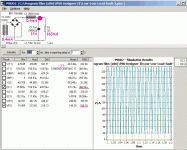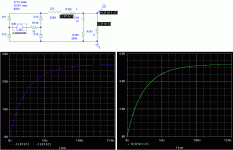Kirchhoff’s Law: "The algebraic sum of all currents entering and exiting a node must equal zero"
I have found an extreme case where PSUD violates Kirchhoff. Choke L1 passes nearly 0.4mA. Cap C1 is near-none. But load R1 has 165mA. Free Current!(?)
It also seems unlikely that R1 Voltage can be jumping so much. Yes BR1 output jumps, but L1 should work near constant-current, therefore constant voltage in R1, with L1 absorbing the voltage difference.
This is part of an attempt to simulate a choke-only supply. Such supplies _are_ in use for welding and plating. The output can be arbitrarily smooth. In "our" own little field (audio) they are rarely seen- we like an audio-solid lo-Z output. But a perverted mind can easily find uses.
The 2 Ohm load is low, but not essential to show this issue.
I wrangled it in Orcad pSpice. Convergence slow. The results do come close to a hand-calc approximation. Basically Vrms * 0.9 * resistance ratio. And do not violate Kirchhoff!
Low-Low-Load-fault-3.gif
Low-Low-Load-fault-3-SPICE.gif
Low-Low-Load-fault-3.psu
I have found an extreme case where PSUD violates Kirchhoff. Choke L1 passes nearly 0.4mA. Cap C1 is near-none. But load R1 has 165mA. Free Current!(?)
It also seems unlikely that R1 Voltage can be jumping so much. Yes BR1 output jumps, but L1 should work near constant-current, therefore constant voltage in R1, with L1 absorbing the voltage difference.
This is part of an attempt to simulate a choke-only supply. Such supplies _are_ in use for welding and plating. The output can be arbitrarily smooth. In "our" own little field (audio) they are rarely seen- we like an audio-solid lo-Z output. But a perverted mind can easily find uses.
The 2 Ohm load is low, but not essential to show this issue.
I wrangled it in Orcad pSpice. Convergence slow. The results do come close to a hand-calc approximation. Basically Vrms * 0.9 * resistance ratio. And do not violate Kirchhoff!
Low-Low-Load-fault-3.gif
Low-Low-Load-fault-3-SPICE.gif
Low-Low-Load-fault-3.psu
Attachments
It's probably related to a PSUD simplification where C is assumed as just an ideal C, and the ESR is added in as secondary calculation and assumed to be minimal.
It would be more helpful to post a notice about this software bug in the Thread opened for PSUD2 replacement.
Then the software writer could address the error.
Or Email the writer via his website.
Then the software writer could address the error.
Or Email the writer via his website.
Maybe PSUD2 uses integer variables.
With these irrealistic part values the required range of calculations exceeds 32 bit.
This is a tool, not a toy, abusing leads to unpredictable results.
With these irrealistic part values the required range of calculations exceeds 32 bit.
This is a tool, not a toy, abusing leads to unpredictable results.
Well, with much more realistic values (T1 50V 140 mohm, C=1uF, ESR=100, L=1H, R1=2ohm) it also gives wrong result...
Something is basically wrong in the equations.
Something is basically wrong in the equations.
Last edited:
- Status
- Not open for further replies.

